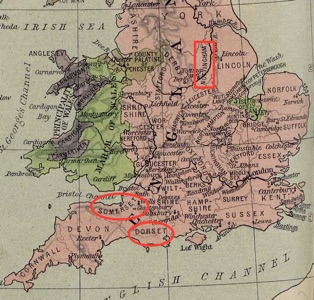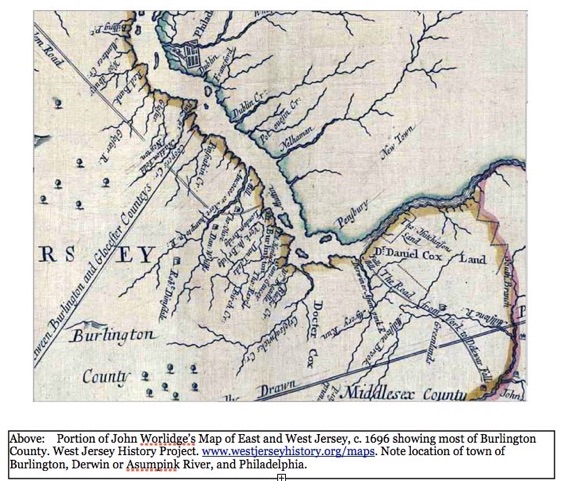DONNA BINGHAM MUNGER
My Own Website
Author, Educator, Historian, Genealogist


DONNA BINGHAM MUNGER
My Own Website
Author, Educator, Historian, Genealogist









ANCESTORS AND DESCENDANTS OF WILLIAM BINGHAM
OF PHILADELPHIA
[1640 - 1915]
Donna Bingham Munger
Generation One: England and America
The Great Great Grandparents of William Bingham of Philadelphia
1. James BINGHAM
Died: 1670, Newport, Essex, ENG
Mar: abt 1660 Bridget WOODLEY (John Woodley); Born: abt 1640, Newport, Essex,
ENG; Mar (2): 3 Sep 1687 William WATSON Chesterfield, West Jersey®1, p. 37
Mar (1): Anne Redding; Died: abt 1711®50
Died: 3rd of the 4th month 1702, Burlington, West Jersey; Buried: 1702 Nottingham, Burlington, West Jersey, “in the burying place”.®50
Documents at the Essex County Archives, England, recently placed online, leave no doubt as to the identification of William Bingham of Philadelphia’s last English ancestor and his first American ancestor. Accordingly, much misinformation copied from earlier sources and now also online or in print, needs to be corrected. Following next is the information that the documents contain.
For two years in a row, 1670 and 1671, the constables for Newport, Essex, presented Bridgett Bingham, the wife of James Bingham, for absenting herself from the parish Church. In 1670 it was for “three seuerall sondayes last past”.®43, Reference: T/A 418/172/84 In 1671, named a widow, Bridgett Bingham was presented again for absenting herself from church for 4 Sundays.®43, Reference: T/A 418/173/88
That same year, 1671, Bridget Bingham of Newport, widow, and Benj. Scott, jun. of Widdington, yeo., and w. Margt (both daughters of John Woodley, late of Widdington, yeoman, deceased), were fined for attending an illegal Friends Meeting and a deed declaring the uses of the fine was recorded.®44, Reference: D/DC/41/463; ®50
From these three documents we know that Bridget and Margaret were daughters of John Woodley, that Bridget’s husband had been James Bingham and that Margaret’s husband was Benjamin Scott. We also know that James Bingham died in 1670 or 1671.
Further investigation of the Essex Parish Registers should reveal even more information about these families.
The next we know about Bridget is a record of her 1681 emigration on the ship Henry and Ann sailing from Gravesend.®2 Also on ship were her sister Margaret Scott and husband Benjamin. The Scott’s daughter, Elizabeth, was born on board the “7th of ye 5th month” 1681.®2 Bridget, her son, James Bingham, and three daughters, Mary, Ann and Margaret, had arrived in the Delaware Valley by the “first Day of ye Tenth month” 1681 when she attended another birth.®2 Hinshaw recorded Bridget as a widow from Essex migrating to Burlington, NJ with son and 3 daughters.®3
Burlington was the seat of government for the Quaker province of West Jersey. Between 1675 and 1701, West Jersey functioned as a private colony ruled first by John Fenwick, then Edward Byllinge, and finally Daniel Coxe, all Quakers. Coxe sold his interest in 1792 to the 48 members of the West Jersey Society, most of whom were Anglicans. In 1701, the British crown resumed control of all private colonies including West Jersey.
On May 8, 1684 brother-in-law Benjamin Scott, deeded Bridget Bingham the use of 200 acres of his 500 acre tract adjoining the land of George Elkington in the 2nd 10th in Burlington. Benjamin deeded the use of the remaining 300 acres of the tract to Martin Scott, his son.®4, p. 442
Six years after arriving in Burlington and sixteen years after husband James Bingham had died, Bridget Bingham, a widow of Burlington, married William Watson in November 1687.®50
William Watson had emigrated near the end of August 1684 in the ship Bristol Merchant with his three sons, William, Isaac, and John; one daughter, Elizabeth; and two male servants. Their trip took “neare eight weeks”. They arrived safe in Philadelphia before November 4 and rented part of a house for four weeks; there, son William died and was buried.®50
Watson settled in Nottingham Township, Burlington, West Jersey where there were already several others from Watson’s native Nottingham, England. But there was no Friends meeting in Nottingham, West Jersey so William Watson attended the Chesterfield Township Monthly Meeting. That was where he met Bridget Bingham.
On the 6th of the 8th month, 1687 he announced at Chesterfield Meeting that he intended taking Bridget Bingham, a widow of Burlington, as wife. He had already announced his intentions at Burlington Meeting 3 days before. On 3 of the 9th month at Chesterfield and 4 days (7 9m) later at Burlington, they were given liberty to marry.®50
By then, two of Bridget’s daughters had married. Mary on 13 January 1683 married George Elkincton and Ann in 1685 married William Satterwaite.®5; ®6 Bridget’s two other children, James and Margaret, married within a few years. On November 30, 1687 Bridgett Bingham assigned her 200 acres to son James Bingham who conveyed the same to John Scott, son of Benjamin Scott.®4, p. 442 (marginal note)
Watson became active in community affairs and established himself at a place named Farnsfield along the division line between East and West Jersey on both sides of the Assunpink Creek. Farnsfield was named after his residence of the same name in Nottingham, England.
Bridget’s name appears only one more time when on 26 October 1691 she was a witness to the will of Percival Towle of Burlington.®50 Watson was involved in the settlement of Towle’s estate.
In 1699, William Watson sold his 400 acre property on Doctor’s Creek and transferred his 250 acre tract on Assunpink to his son, John. He then began to work on surveying property he owned in Pennsylvania. Before the surveys were complete Bridget died and was buried 3 June 1701 “in the burying place in Nottingham.”®50
William Watson lived until 1711 or 1712. Three of his four children predeceased him leaving son Isaac as his sole heir.®50
Besides the sources cited, researchers may want to consult the Records of Chesterfield Monthly Meeting in the Friends Historical Library of Swarthmore College. Further research can also be done in the West Jersey Proprietor’s records available since 2005 at the New Jersey State Archives. For a thorough explanation about “Using the Records of the East and West Jersey Proprietors” download a 35 page lecture by Joseph R. Kletts at www.state.nj.us/state/darm/links/pdf/proprietors.pdf
Children
1.1. Mary abt 1662
1.2. Ann abt 1664
1.3. James abt 1666
1.4. Margaret abt 1668
Generation Two: America
The Great Grandparents of William Bingham of Philadelphia
CHILDREN OF JAMES BINGHAM
1.1. Mary (James)
Born: abt 1662, ENG; Mar: 13 Jan 1683 George ELKINCTON, Burlington, NJ
before Samuel Jennings, Governor, Thomas Gardner and Thomas Budd,
Justices, etc.®22: 86; ®5
1.2. Ann (James)
Born: abt 1664, ENG; Mar: 1685 William SATTERWAITE Burlington, NJ®6
In 1685 when Ann married she was “late servate” of Thomas Oliver®6
1.3. James BINGHAM (James)
Born: abt 1666, Newport, Essex, ENG
Mar: abt 1692 Ann STI[Y]LES®8; Died: 1750, Philadelphia, Philadelphia, PA; Buried: 11 Oct 1750, Christ Church,
Philadelphia, Phila., PA®10: 1: 461
Died: 1714, Philadelphia, Philadelphia, PA; Will: 16 Dec 1714, Philadelphia, Philadelphia, PA; Recorded 10 Jan
1714/15®9; Buried: 22 Dec 1714, Christ Church, Philadelphia, Philadelphia, PA®10, 1: 460-61
James Bingham, the only son of Bridget Woodley and James Bingham, accompanied his mother and three sisters when they emigrated from England in 1681. If he was twenty-one in 1687 when his mother conveyed 200 acres to him shortly before she married William Watson, James would have been born about 1666 and immigrated to West Jersey with his mother when he was about fifteen. His native town was probably Newport, Essex, England.
The 200 acres he received from his mother had been part of a 500 acre tract that uncle-in-law Benjamin Scott originally owned in Burlington County, West Jersey. James conveyed the same to John Scott, his cousin and son of Benjamin 30 November 1687.®4: 442
A year later, 19 November 1688, a survey was made for James Bingham of 600 acres on the north branch of Pensauken Creek between the lands of William Hulings and George Smith.®4: 371
Judging from his land activities and the probable ages of his children, James married about this same time. His wife, Ann, mentioned in his will, was the sister of Robert Stiles who chose James, his brother-in-law, to be the executor of his will dated 2 June 1711. Robert and Margaret Styles home farm of 207 acres was on Pensauken Creek.®51: 442
On 7 November 1691, John Scott sold to James Bingham, both of Burlington Co., NJ, yeomen, 200 acres that John had bought from his father Benjamin Scott and uncle William Scott 3 April 1677.®4: 443
By 1693, James and Ann lived in Evesham Township, Burlington County, West Jersey on a plantation south of the north branch of Pensaukin Creek bought from Samuel Coal 13 April 1693. On 2 November 1696 James sold 50 A from the N.E. corner of the plantation to Jonathan Eldridge, cordwainer, also of Evesham Township.®4: 493
James bought another 200 acres in West Jersey on 10 April 1700 from John Wills of Northampton Township, Burlington Co., NJ. This land was part of the 1/4 share belonging to the grantor’s father Daniel Wills.®4: 522
James’s cousin John Scott of Wellingborough, Burlington, West Jersey died in 1702 and in his will dated 6 April 1702 he mentioned James Bingham and James’ three youngest children as one of several legacies.
Shortly thereafter, James moved to Philadelphia where he was admitted to the privileges of freeman on 9 April 1705 by paying the required tax.®7, I, “Minutes of the Common Council.” But James’ friends in West Jersey did not forget him for on 15 July 1714 George Smith of Evesham included James Bingham’s children in his will.®51: 426
James died between 16 and 22 December 1714 and was buried at Christ Church 22 December.®10 He left a considerable estate to his heirs. His will dated 16 December left to wife Ann, £50, the cow, team of horses, carriages and other gear belonging to the team, and all household goods. James established his son-in-law John Heap of Philadelphia, shipwright and husband of daughter Ann, and his trusty friend Josiah Appleton of Philadelphia, cooper, trustees of all that messuage in which he dwelled to use for Ann, wife, and after Ann’s death to be sold and divided among children James, Ann, Mary, Elizabeth, and Hannah. He also left to his trustees his tenement on High Street commonly called ye “Sign of the Crown” and 2 plantations in Evesham, Burlington, NJ, one of 400 acres in tenure of Daniel Cuncrant, the other 350 acres in tenure of Thomas Smith, in trust, to sell the same and proceeds to be divided equally among his children. To his son, James, he willed £100 to be available at the end of his apprenticeship and to sister Margaret Styles £5.®9
Note that both this James Bingham and father James Bingham died in their forties or early fifties, a pattern that continued in the family.
Children
1.3.1. Ann abt 1693
1.3.2. James 1694
1.3.3. Mary abt 1695
1.3.4. Elizabeth
1.3.5. Hannah
To read and download the rest of the article, click on the words in Green: William Bingham of Philadelphia .pdf



Donna Bingham Munger asserts her right to be identified as the author of this website.